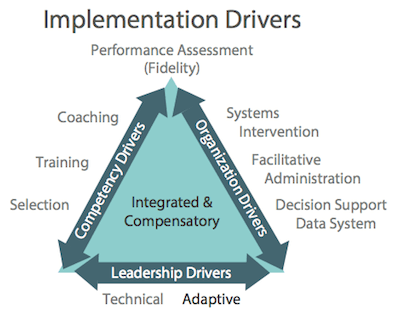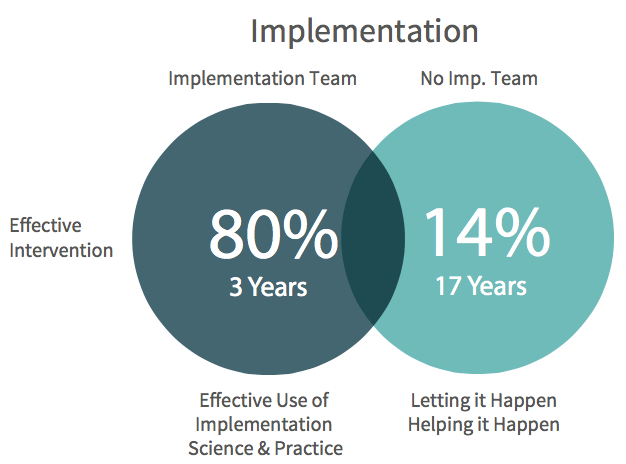Implementation: The Case for Using a Systematic Approach to Software Implementation
August 17th, 2015
Schools and districts frequently expend considerable resources putting in place a variety of interventions, operating procedures, curricula, professional development and technology systems. These include not only the cost of tangible products but often involve considerable dollars for staff training plus the hidden costs to students of having classroom teachers removed from the classroom.Most districts take a “let it happen” approach to implementation and extensive research has indicated that only 14% of these types of poorly managed implementations actually result in substantive changes in staff behavior and performance after an average of 17 years of implementation efforts (Blasé & Fixen, 2007).
To address the ineffective nature of most implementations, the field of “Implementation Science” emerged to create generalizable knowledge that can be applied across settings and contexts to answer central questions. What are the central components of effective implementations? Why do established programs lose effectiveness over days, weeks, or months? Why do innovations sometimes exhibit unintended effects when transferred to a new setting? (Madon, T., Hofman, KJ., Kumfer, L. & Glass, RI., 2007).
It is common for people to conceive of an “implementation” program or practice as if it were a single, unitary construct. Successful implementations are not merely an attempt to put in place a program or practice but an on-going, recursive process that is integrated with the actual program, practice or software system. In this regard, the implementation process and the program or practice are inextricable and should not be assumed any more than the intervention outcomes themselves.Therefore, when thinking about implementation one must be aware of two sets of interconnected processes (innovation or software system activity and general implementation activity) and two sets of outcomes: innovation-level outcomes and implementation-level outcomes.A formula for successful uses of evidence-based programs in typical settings can be characterized as:

The effective use of innovative programs or software systems requires behavior change at the teacher and the administrative support levels. Training and coaching are the primary ways in which behavior change is created in staff at all stages of implementation (Dufrene, et al., 2005).
The Active Implementation Framework:Well‐operationalized innovations can be taught and coached so educators can use them with fidelity.
- Effective Innovations – Software systems need to be teachable, learnable, doable, and readily assessed in practice if it is to be used effectively to reach all students who could benefit.
- Implementation Teams support the full, effective, and sustained use of the software platform and changes in staff behavior.

-
Implementation Drivers assure development of relevant competencies, necessary organization supports, and engaged leadership around innovative software systems.
- Implementation Stages outline the integrated, non‐linear process of deciding to use an effective software system and finally having it fully in place to realize the promised outcomes. Active implementation stages are:- Exploration: Establish district implementation teams, set goals, tactics and strategies.
– Installation: School teams, buy-in, communication, fidelity measures, coaching plan, initial training.- Initial: Implement new practices, additional training, coaching, feedback and monitoring.- Full: Standards of practice are evident, refined coaching, expand and replicate, review goals, add new functionality.- Innovation: Best practices with fidelity across system, refinement, innovative practices observed, greater efficiency, impervious to leadership change
-
Implementation Cycles support systematic and intentional change. Improvement Cycles are based on the Plan, Do, Study, Act (PDSA) process for rapidly changing methods and changes in software functionality, organization supports and practice‐policy communication cycles for changing systems to enable continual improvement in impact and efficiency.
As noted above, there is a tendency for school districts when installing a new software system to focus solely on getting to the “Go Live” state of software installation while ignoring the implementation processes outlined here. What the implementation science literature has demonstrated is that if the software system is expected to produce significant changes in educator behavior and student performance there must be equal and complementary efforts directed toward the process of implementation in order to achieve a high probability of positive impacts on students.Download the the full white paper by filling out this form.Author: Dr. Chris Balow, Ph.D, Illuminate Education



Great ideas.